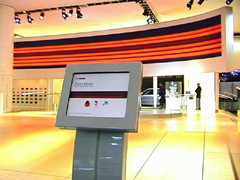
Mazda LED wall/zoom media
Imagination Group, Ltd., New York, New York, 2003
Description
Mazda, a Japanese car brand and a division of Ford Motor Company, wished to communicate the Mazda brand in a way that would engage visitors to the North America International Auto Show (NAIAS) 2003 stand. To stand out at NAIAS, Mazda required its stand to be distinctly different. Mazda also wished to communicate contemporary Japanese culture in a way that would be understandable to a predominantly U.S.-based audience of consumers, press and people in the automobile industry.
The background and ambience of Mazda’s presence at auto shows throughout 2003 (and extending into 2004) has been provided by a giant interactive LED wall (66 feet by 9 feet) running across the back of the stand.
In order to satisfy Mazda’s desire to link their brand values with contemporary Japan for a primarily American audience, Imagination chose five themes—technology, architecture, city, nature and fashion—on which to base the content of the LED wall. Rather than using more traditional running shots of cars, footage of Mazda’s product range was then interwoven with highly animated graphics, producing a set of three-minute custom-designed animations based around these five themes.
Audio was produced by a Tokyo-based studio, who commissioned separate Japanese composers for each of the main themes, resulting in highly distinctive mood pieces ranging from contemporary Japanese pop to near ambient soundscapes that further reinforced the underlying brand values.
Finally, Imagination introduced a software-based design solution that would allow the audience to influence the environment through both look and sound, and transforming a passive video wall into a live and dynamic audio-visual canvas.
Design solution
Each of the five main themes was designed for the specific needs of the extended letterbox format of the LED wall, and run as QuickTime animations from a PC-based delivery system. Animated graphic elements, 3-D generated car components, video, photographs and illustrative material were woven together into a seamless and highly distinctive style.
Visitors use touch-screen stations to interact with the five animated themes, introducing real-time 3-D elements and controlling the soundscape as if with a large-scale mixing desk.
Each theme had an individual set of icons that the visitor could drop onto the video wall via the touch screen. This interactivity created real-time 3-D elements within the animation, each with its own life, characteristics and movement. Each icon within a theme controlled its own audio track, thereby changing the ambience to the entire stand as the soundscape altered in response to visitors playing with the system. An otherwise passive environment was thus brought to life via an individual’s interaction.
The software delivering the application to the giant 66 x 9–foot Barco LED video wall was coded as a DirectX application controlling video and audio playback within a 3-D model space, running on a Windows 2000 network composed of a server and up to three interactive clients. Premiered at Detroit, the custom software allows complete flexibility of both system and user configuration for different show environments.
The success of the project has been demonstrated by both its longevity and adaptability. Since it was first commissioned in mid 2002, the project has been revised for motor shows and audiences worldwide over 2003 and 2004. Variations have now been produced in formats ranging from its original 9:1 letterbox format to standard 4:3 format, and for delivery systems from motor show LED walls to stand-alone DVD players.
The total budget for the project was approximately $425,000.
Juror Notes
Liked the ability to affect your environment. Simple immersive media, impacts your experience at the car show. Represents one end of the technology spectrum: intimacy versus remoteness.
Credits
- Design firm
- Imagination Group, Ltd.
- Creative director
- Damian Ferrar
- Art director
- David Chamberlain
- Designer
- Lisa O’Neill
- Illustrator
- Tyrone Lou
- Production director
- Clare Johnston
- Editor
- Barney Hewlett
- Music
- Syn Studios
- Sound designer
- Nick Woods
- Producer
- Andrew Mckinna
- Typeface
- Helvetica Neue
- Client
- Mazda Motor Corporation